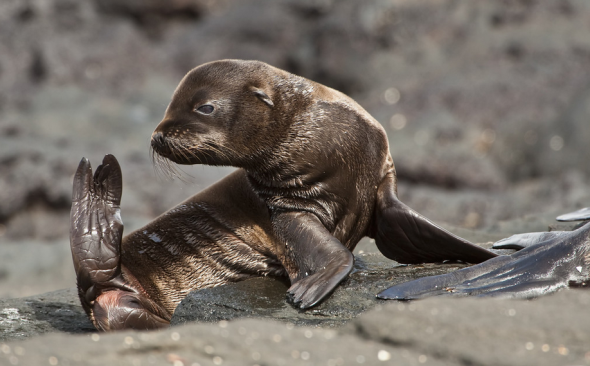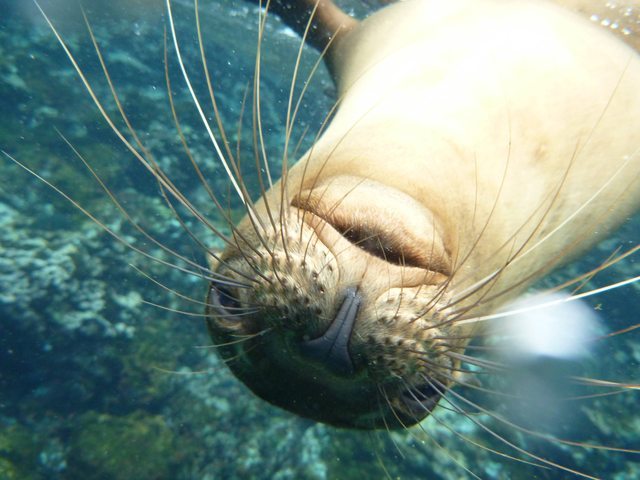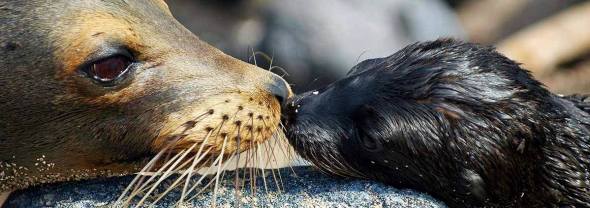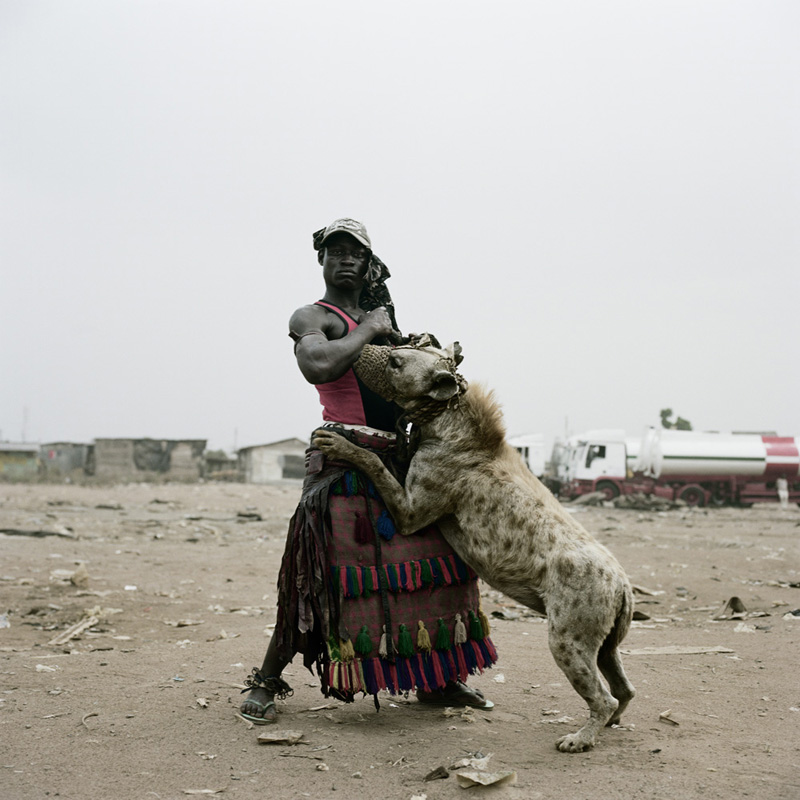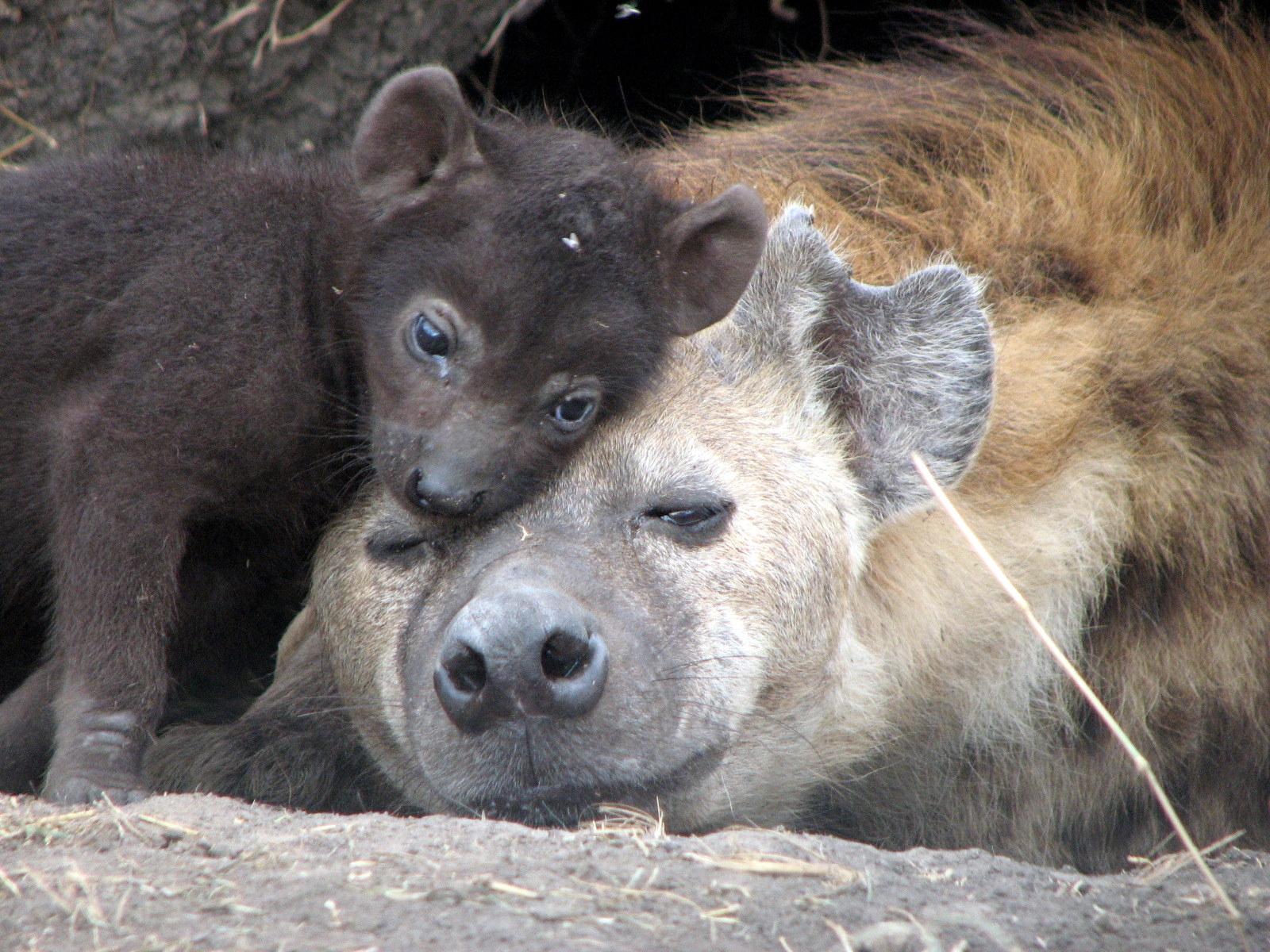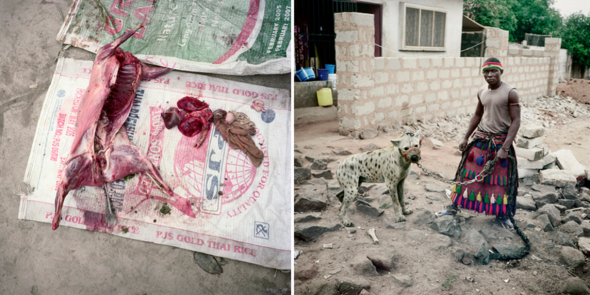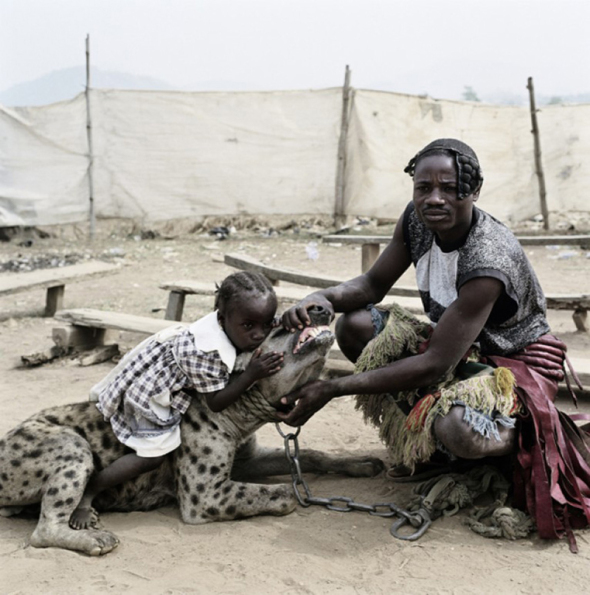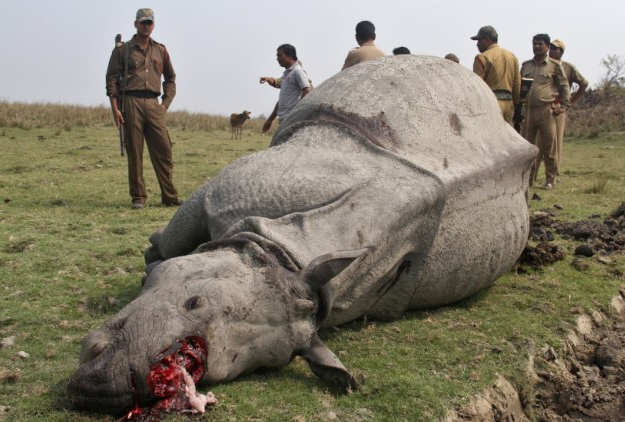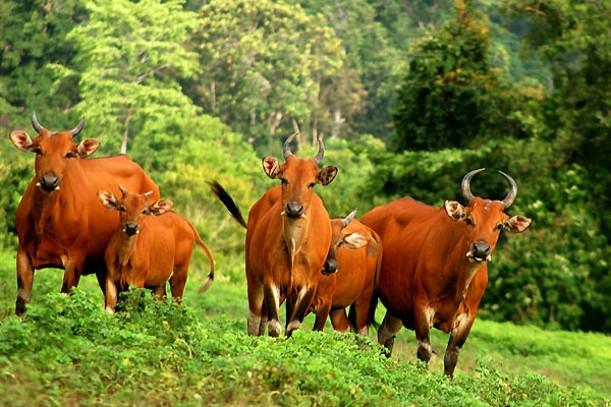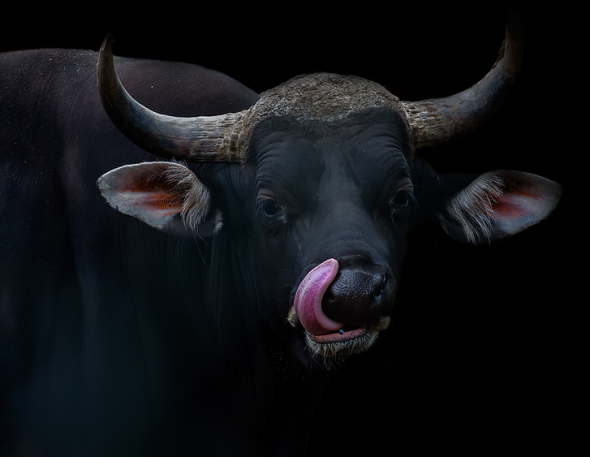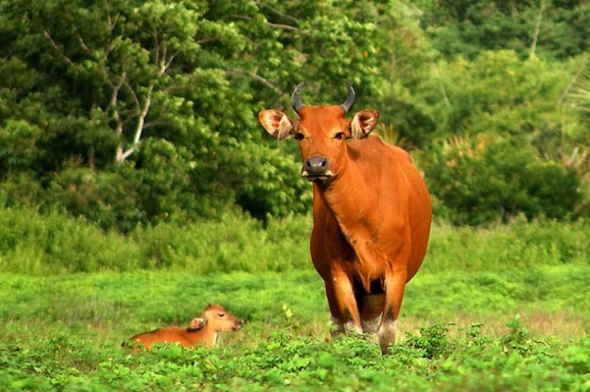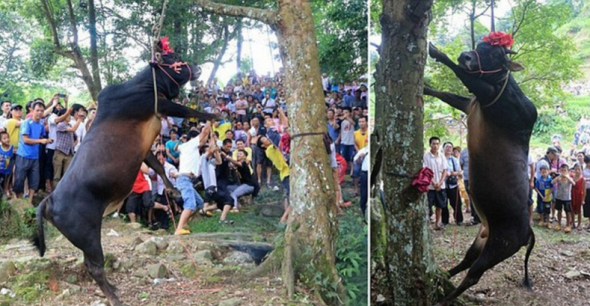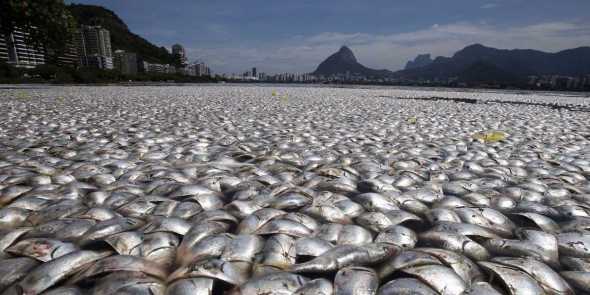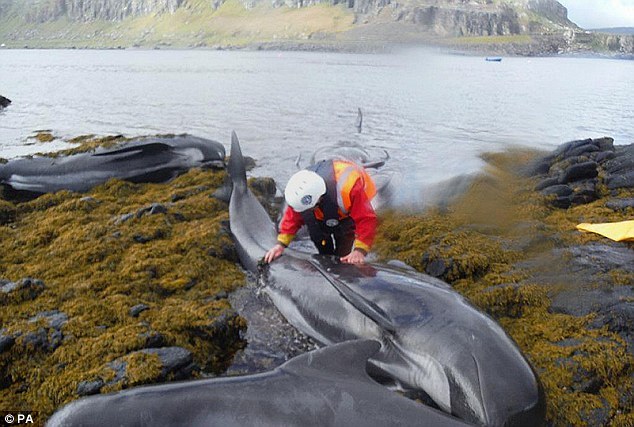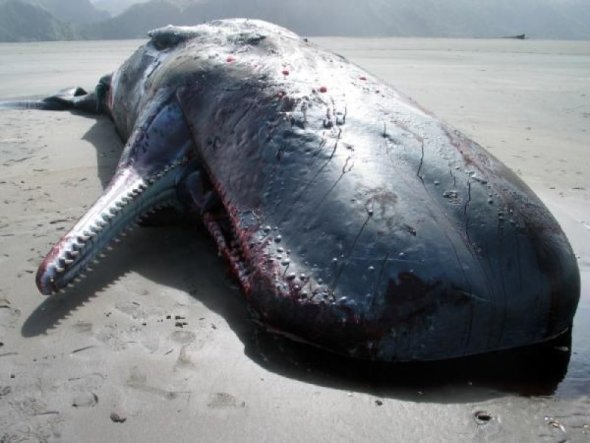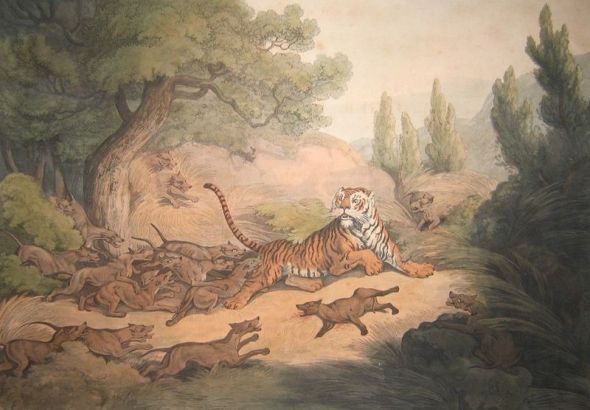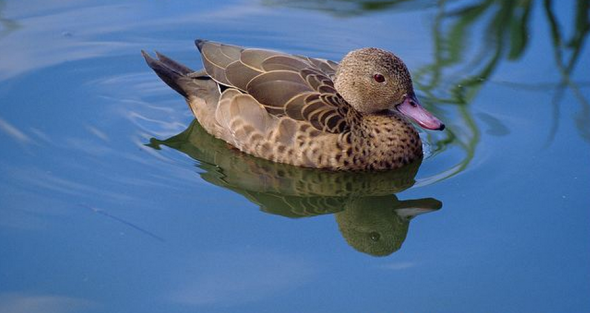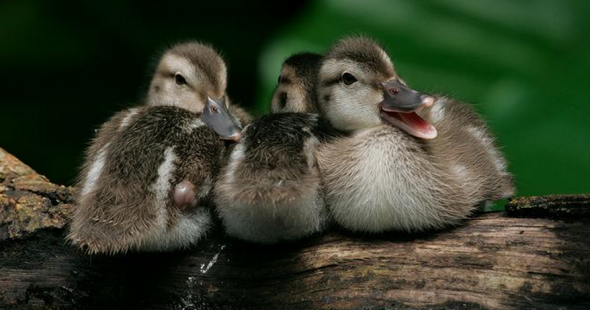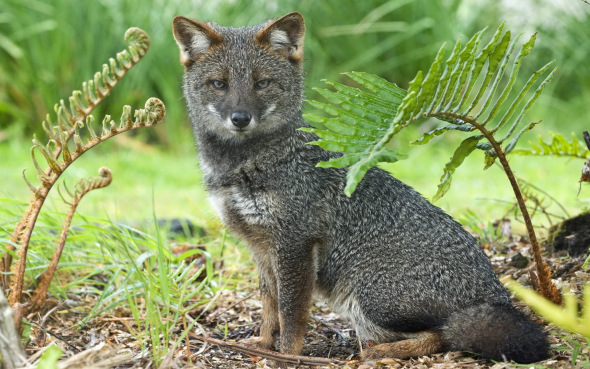Endangered Species Friday - Arctocephalus galapagoensis
Endangered Species Friday - Arctocephalus galapagoensis
This Fridays endangered species article we take a brief look into the life of the Galapagos Fur Seal, scientifically identified as Arctocephalus galapagoensis, and identified back in 1904 by marine biologist Dr Heller. Listed as endangered the species is endemic to Ecuador, and the Pacific South East. Pictured above is one of many declining colonies of the Galapagos Fur Seal Pups (credited to Stephanie Brand) from Arizona, United States.
Back in 1982 the species was officially declared “out of danger” however from 2010 reports soon came flocking in that the Galapagos Fur Seal was again listing back into its old threatened status. From 1996 evaluations of the species saw A. galapagoensis relisted as (vulnerable).
Further opinionated evaluations by marine biologists Baillie and Groombridge confirmed the species was sadly nearing the realms of endangerment (1996). Census’s of A. galapagoensis (2010) have unfortunately relisted the species as now (endangered). A final evaluation of species populations now confirms populations are declining, very rapidly.
Back in 1978 environmentalists conducted a marine census of the species that placed the population size at some 30,000 to 40,000 individuals. El Niño which is the warm phase of the El Niño Southern Oscillation (commonly called ENSO) and is associated with a band of warm ocean water that develops in the central and east-central equatorial Pacific (between approximately the International Date Line and 120°W), including off the Pacific coast of South America, has been blamed for high mortality rates of seal pups.
Image: Galapagos Fur Seal
Population sizes have been said to be (fluctuating) since the last in-depth populastion report on the species back in the mid to late nineteen seventies. Recovery since this time is currently unknown, however reports from 2010 can be viewed here that do provide further although little information on recovery at least. Surveys undertaken since the last 2010 report now place the number of A. galapagoensis at a depressing 10,000 to 15,000 individuals. That’s quite a significantly large decline since the species last census count, and on discovery of which population sizes were over 70,000-90,000 individuals 1904-1908-(census).
Galápagos Fur Seals live in large colonies on the rocky shores. These colonies are then divided into territories by the female seals during breeding season, which is mid-August to mid-November. Every mother seal claims a territory for herself and breeds her pup there. Galápagos Fur Seals have the lowest reproductive rate reported in seals, and it takes an unusually long time to raise seal pups to independence.
Females bear only one pup at a time, and she remains with her newborn for a week before leaving to feed. She then periodically returns to the pup and stays to suckle it for a few days before leaving on another hunting trip. Females recognize their own pups by smell and sound, and pups also learn to identify their mothers by the females’ “Pup Attraction Calls”.
Mother-pup recognition is crucial because females exclusively nurse their own pups, often violently rejecting strange pups that approach. Orphaned seal pups usually try to sneak up on sleeping or calling females to suckle, but stealing milk is not enough to sustain the pups, and they usually die within a month.
The Galápagos Fur Seal feeds primarily on fish and cephalopods. They feed relatively close to shore and near the surface, but have been seen at depths of 169 m (554 ft). They primarily feed at night because their prey is much easier to catch then. During normal years, food is relatively plentiful. However, during an El Niño year, there can be fierce competition for food, and many young pups die during these years. The adult seals feed themselves before their young and during particularly rough El Niño years, most of the young seal populations will die.
The Galápagos Fur Seal has virtually no constant predators. Occasionally, sharks and orcas have been seen feeding on the seals, but this is very rare. Sharks and orcas are the main predator of most other seal species, but their migration paths do not usually pass the Galápagos.
Image: Galapagos Fur Seal and Cub
Threats
Similar to all southern fur seals there was a severe population decline as a result of 19th century exploitation by sealers and whalers. The species was near extinction early in the 20th century and has since recovered (although as explained species populations are declining and the Galapagos Fur Seal species are listed as endangered).
El Niño events dramatically elevate mortality rates of all age classes and cause population declines; this is due to the dramatic declines in productivity around the Archipelago during these events. Tourism in the Galápagos, which is an Ecuadorian National Park, is heavy but regulated, and fur seals are protected.
Episodes of entanglement in local net fisheries have been reported and are thought to be increasing over the last years. Feral dogs on Isabela Island which killed fur seals of all ages have been exterminated. This problem could erupt again if other feral dogs find their way to colony sites.
The most serious threat at present is transmission of diseases from dogs to pinnipeds. Like all fur seals, Galápagos Fur Seals are vulnerable to oil spills because of their dependence on their thick pelage for thermoregulation. Although there is limited large vessel traffic in the Galápagos Archipelago, numerous small and medium sized vessels operate in the area that could release moderate quantities of oils, fuels, and lubricants if involved in a marine accident.
Galápagos Fur Seals have experienced declines from El Niño-caused ocean warming and associated reduced marine productivity (Trillmich and Dellinger 1991) estimated of up to 80%, but the exact extent of population reduction is not clear. Therefore, although the effects of global climate change on this species and its habitat are uncertain at this time, it is possible that any change related disruption of present day ocean currents, levels of marine productivity, or increased air temperatures at haul out sites would adversely affect this species.
Despite their population size, the Galápagos Fur Seal population will always be vulnerable to a variety of threats because of the species’ restricted distribution to a relatively small Archipelago of islands.
International Animal Rescue Foundation Brazil worked with these stunning animals for approximately a year and a half. The South American organisation has sadly stated that the species may soon be extinct within the next decade. Despite “any” protection measures that we or other throw at the species we have non-human and non-animal natural events that could wipe the entire species out in a single El Nino season.
Thank you for reading.
Chief Executive Officer/Chief Environmental Officer
Dr Jose C. Depre.
International Animal Rescue Foundation Africa - Asia.
Chief Environmental Officer South America and Europe. (Head Registrar).
Dr J. Williamson EnVstu. PhD, Ba.
International Animal Rescue Foundation Europa - South America - United States
Have you spotted a typo or error? Please email us above and we’ll work to rectify the problem as soon as possible.
Africa: Culture, Abuse & Crime. Hyena Boys.
Abuse or Culture?
Its been a long time since I last documented on the hyena men within Nigeria. My last article was more focusing on why men feel the need to take any animal from its natural habitat, drugging the animals into submission thus in a way domesticating them. Peter Hugo was one of the very first men to document and illustrate on this rather strange and morbid behavior of both man and animals.
This Wednesdays article focuses more on whether such domestication of wild hyenas (or any animals from the wild) is considered abusive or culture and, will such a “fashion trend” spread into neighboring countries on the continent of Africa? Yes, you did just read that correctly - hyenas are seen by some people (mainly men) within Nigeria as a fashion statement over dogs. Yet the hyena is more closely related to cats and not dogs.
Brief hyena history:
Hyenas or hyaenas (from Greek ὕαινα hýaina) are the animals of the family Hyaenidae /haɪˈɛnɨdiː/ of the feliform suborder of the Carnivora. With only four extant species, it is the fifth-smallest biological family in the Carnivora, and one of the smallest in the class Mammalia. Despite their low diversity, hyenas are unique and vital components of most African ecosystems.
Within Western African tradition hyenas have been known to mingle and interact with humans. The spotted hyena was considered a “bad Muslim” who challenge the local animism that exists among the Beng in Côte d’Ivoire. In East Africa, Tabwa mythology portrays the spotted hyena as a solar animal that first brought the sun to warm the cold earth, while West African folklore generally shows the hyena as symbolizing immorality, dirty habits, the reversal of normal activities, and other negative traits. In Tanzania, there is a belief that witches use spotted hyenas as mounts.
In the Mtwara Region of Tanzania, it is believed that a child born at night while a hyena is crying will likely grow up to be a thief. In the same area, hyena faeces are believed to enable a child to walk at an early age, thus it is not uncommon in that area to see children with hyena dung wrapped in their clothes.
Image: Hyena and cub.
The Kaguru of Tanzania and the Kujamaat of Southern Senegal view hyenas as inedible and greedy hermaphrodites. A mythical African tribe called the Bouda is reputed to house members able to transform into hyenas. A similar myth occurs in Mansoa. These “werehyenas” are executed when discovered, but do not revert to their human form when killed. In all hyena’s are pretty much disliked among many traditional communities and are thought to bring a whole host of bad spirits and bad luck.
The hyena men and hyena man:
There are two groups of hyena men known. The first resides in Nigeria known as travelling performers while in Ethiopia there remains a “hyena man” rather than “men” named as Yusef. The Nigerian hyena men were first photographed by Peter Hugo. Nigerian hyena men are known to capture hyena’s, baboons and pythons of which are then tamed aggressively which we believe the use of powerful narcotics or veterinary tranquilizers are used to heavily subdue or sedate the animals removing their primal hunting instincts and natural behavior thus converting to human slavery.
Noted as travelling performers the hyena men are said to care for their animals while travelling the country followed by many whom shower the men with Naira (Nigerian currency). From observing reports it seems that the hyena men are really no different to the Monks of Tiger Temple in Indonesia. Drug and herbal concoctions are administered to subdue the animals before being captured and when on display to ensure the men are not injured or even killed by these aggressive carnivores. Peter Hugo also described how the men bathe in an unknown medical concoction of herbs as well as drinking medicinal concoctions in the belief that this will protect the men from harm when hunting and capturing the animals for later human domestication.
On hunting the hyena down with dogs the men are then said to blow a white tranquilizing powder into the face of the hyena in the hope to subdue it once the beast has been coaxed out its den. Once the hyena is subdued the men are then said to cage the animal before bringing the animal back to the local village community. Mr Hugo described that when the hyena’s are captured the hyena men then rub a unknown medicine onto the body of the hyena that is said to make the animal completely obedient.
Environmental News and Media are not quite sure as to what the medicine is or even if any such “medical rub” is administered that has any form of active properties to help subdue the animals. Its quite possible the “white powder” that is blown into the face of the animal could be “Diazepam” which would explain why the animal is then quickly subdued and for long periods of time. We don’t believe that any such skin rub that is administered to the animal would then make the animal[s] completely obedient. For such a large predatory animal to be subdued completely one would require a significantly large dose of analgesia, opiates or a stronger barbiturate to fully contain and subdue the animal. That would then be considered as abuse and something which is a violation under the Nigerian Animal Welfare Law.
Image: Hyena boys with muzzled Hyena.
Once the hyena is under the complete control of its handlers the handler will then teach the animal performing tricks and, how to live with its captive abductors (see video below). We do find this again quite baffling to take on board as hyena’s are natural born killers, very predatory and, on viewing the imagery taken by Peter Hugo it clearly shows multiple hyenas heavily chained and muzzled. So in all fairness while some people have been led to believe this is all OK its quite possible that these stunning animals are being fed a heavy dose of tranquilizers and/or depressive human or animal related relaxation medications.
Due to Nigeria’s rampant poverty the handlers were/are “allegedly forced” to parade their captive animals through the local community streets of which any raised money is said to be used to fend and care for the animals well being. In reality any money that is raised or stolen is used to feed their alleged narcotic habit and crime.
Baboons will perform a variety of tricks of which money is handed over to either animal or animals handler. Unfortunately the main earners are hyenas. Another concern raised was that many abducted animals are sold onto zoological gardens within the country that’s seen as another money maker. Peter Hugo quoted “The hyena men of Nigeria do more than simply put on a street show but they provide medicine to the public and more importantly stimulate the economy of whatever area they are in as well as act as a cultural product from the area”.
Meanwhile on the outskirts of Harar, Ethiopia another hyena man is said to exist known as Yusef. Yusef does not make money from animal performances but more admires their attention - despite these animals belonging to the wild and can at times be very unpredictable. Every night Yusef will feed the visiting hyenas with mule and camel meat. In a way these species of hyena seem to tolerate Yusef and also enjoy his company of which Yusef treats them like domesticated dogs. Many people in Harar are said to actually worship the hyena and treat them with the utmost respect which could explain why they’re not kept as performing animals but left to live how they should within their natural habitat.
Crime and exploitation:
Moving back to the Nigerian hyena men local press and media that picked the story up few years back were quoted as stating “that these men were bank robbers, bodyguards, drug dealers and debt collectors”. Between March 7th and 15th 2015 a local man named as Mr Mohammed Nafiu aged 27 who has been “suspected” of being part of the hyena men group was arrested and charged after using baboons and pythons to rob people within the country.
He pleaded not guilty to the charges. However, the prosecutor, ASP Eranus Nnamonu insisted that the accused committed the offences on March 7 and 17 when he terrorised the residents of Ogba and Ijaiye in Lagos.
He said Mr. Nafiu, armed with a fully grown baboon and a venomous snake, also terrified a crowd waiting to board a bus at Ogba Bus Stop. Mr. Nnamonu said the accused isolated a witness, Joshua Odogwu, and thereafter obtained N57, 000 from him.
“The obviously terrified victim dropped all he had in his bag along with N57, 000 cash, which the accused collected,” he said. In addition, he said the accused had on March 17 visited the shop of a man, Henry Ugwuokoh, and forcefully obtained N230, 000. The offences, Mr. Nnamonu noted, contravened Sections 166, 294, 295 and 409 of the Criminal Law of Lagos State, 2011. In her ruling, the Magistrate, Abimbola Komolafe, granted the accused bail in the sum of N100, 000 with two sureties in like sum and adjourned the case to June 18 2015 for trial to be held tomorrow.
Recently back in 2014 a local documentary-maker Tarryn Crossman won the award for Best Documentary Short for Hyena Boys at the California International Shorts Festival. Despite much criticism and debate from Carte Blanche, 50/50 and environmental and animal welfare groups the “award winning short film” was aired. Since Peter Hugo’s capture on the hyena men now known as the hyena boys, countless film, documentary producers and organisations have visited the group of men headed by Baba Mohammed that is in our eyes creating the wrong image and sending the wrong message to many people that abducting a wild animal to generate money from street performances is OK?
As explained its not just hyena’s that are taken from the wild and held in solitary confinement. Baboons, reptiles, snakes and small monkeys are also removed illegally from the wild. Furthermore the animals are also sold on to individuals within the communities as “pets” or as seen in the image below killed for meat to feed the locals.
Image: Hyena meat carcass and Hyena boy with muzzled hyena.
Yahaya one of the Nigerian, Lagos “hyena men” was quoted as saying “Any animal that people want, we can get for them,’ said Yahaya, who claims that they have supplied hyenas, pythons and other animals to zoos in Nigeria, Cameroon, Burkina Faso and Benin. ‘A mature hyena is sold for one hundred and fifty thousand naira, but a cub is more expensive at two hundred and fifty thousand naira. This is because a cub can be trained. An adult baboon goes for fifteen thousand naira, a young one for eight thousand. A python goes for eight to ten, depending on the size.’”
What has turned in to a street performing activity to make money to “allegedly” feed the impoverished has clearly been heavily exploited too. Capturing these stunning animals from the wild to perform or to sell on as meat or pets is wrong and any film production team that honestly believes this is totally OK are foolish and supportive of animal captivity, abuse and, exploitation.
The entertainers have also been accused by the Nigerian police of using the animals to threaten or intimidate members of the public into parting with money or possessions. In June 2004 a report in Lagos newspaper This Day claimed that an armed ‘gang who used a hyena and a monkey to rob their victims’ had a shootout with police. The report can be read below:
June 2004: Four armed man suspected to be from the group “hyena boys” held up a bank with baboons and hyenas.
Four armed gang who used a hyena and a monkey to rob their victims in Katsina State have been arrested by the police after a gun duel in Bichi, headquarters of Bichi Local Government of Kano State. According to a statement made available to newsmen in Katsina, the robbers who were seven in number went to Kankia market in Kankia Local Government of Katsina State to display with the animals while they robbed their victims of N66,000 during their operation.
Shortly after their operation, the statement added, the robbers took to their heels and they were chased by the police down to Bichi in Kano State where they engaged the police in a gun battle which led to the death of two of the robbers. During the battle with the police, the gang let off the hyena and monkey to fight with the police during which the animals bit one of the policemen who is now lying critically ill at the Katsina General Hospital.
Two of the robbers were killed while four of them arrested on the spot. The police had however killed the two animals during the fight in Bichi. Meanwhile, two robbers have been arrested by the police in Funtua for allegedly burgling the home of the former Minister for Special Duties during the Abacha administration in the country Alhaji Wada Nas.
The hyena boys are known to deal heavily in narcotics which the film crew producer Tarryn Crossman confirmed on visiting the hyena boys back in 2014. Tarryn Crossman stated that on entering the camp they walked into a large camp populated with many people and cannabis laying everywhere. Tarryn Crossman’s own words “We thought we were going to die”.
Captive cruelty and abuse:
For years International Animal Rescue Foundation Africa has documented on animal abuse and captive cruelty however, nothing can be more cruel and abusive than this. Abducting wild animals from their natural habitat with vicious dogs, using hypnotic medications to subdue the animals and beating the animals should they not do what their masters demand. It really baffles us as to why any such film or press agency would even document on such so called traditions knowing their abuse that goes on within camp and outside of camp.
Wild animals in captivity are often anxious about being cooped up. And the stressors of social animals can sound strikingly similar to the popularity concerns of high school girls. Mark Wilson, a neuroscientist at Yerkes National Primate Research Center of Georgia’s Emory University, studies captive female rhesus macaque monkeys, housed in groups as they would live in the wild. The monkeys naturally form a hierarchy with some females dominating others, and subordinates enduring harassment and a general lack of control.
Furthermore and even more worrying is the sheer fact the hyena boys have not tamed wild caught adult hyenas at all. The only thing stopping these dangerous carnivores from ripping their owners to shreds are illicit “unknown” medications that help to subdue the animal and take its inhibitions away therefore doing everything the owner or owners bark at the hyena or other animals. I
have included two images for you to clearly evaluate from research. One depicts an non-muzzled adult hyena and a Tiger from the repulsive Tiger Temple. Both hyenas and tigers are dangerous animals of which their natural instincts are to hunt and be predatory. I have searched in vain for as many images as possible depicting non-muzzled hyenas from the hyena boys camp however, to no avail.
Image (1) and (2) Drug induced state - Subdued Hyena and Tiger.
As one can quite clearly see both tiger and hyena are being man-handled. Neither animals would if not drugged take this abusive treatment for very long before lashing out and seriously harming the owner[s]. Which has led us to believe since Peter Hugo first documented on the hyena boys, the hyenas are clearly drugged with either cannabis that was witnessed at the camp in 2014 by film producer Terryn Crossman or heroin. Furthermore individuals from the Australian organisation known as (Cee4life) have been quoted as witnessing cannabis being fed into Tiger food and possibly Sativex, a liquid cannabis tincture.
Further research and accounts from the hyena men have generally stated that hyenas make very good pets and as they are related to dogs they’d be the ideal candidate for home security. Furthermore my research conducted last year of which I located a earlier video of the hyena men stating “hyenas are the new black mans dogs, pit bulls are for sissies”. So, lets debunk this. Firstly hyenas are nowhere near related to dogs. Hyenas are actually more related to cats. Keeping hyenas as pets is considered the “new image” within Nigeria however, do hyenas actually make good pets?
Although a few people in Africa and Asia find very young hyenas in nature and raise them as pets, these animals generally appear to be extremely unhappy as “domestic companions” as adults, and must often be kept muzzled at all times so that they do not harm people or property One only has to view the videos above that clearly illustrates their unhappiness at being chained and muzzled. A muzzle prevents the hyenas from being able to groom itself properly.
As spotted hyenas need several years of practice to become proficient hunters, and as they are deprived of this practice when reared as pets, it is effectively a death sentence for a captive-reared hyenas to be released into the wild. In addition, pet hyenas cannot be released for fear that they might transfer new pathogens from captive environments into the wild. Upon reaching adulthood, many “pet” hyenas must therefore be euthanized.
Concluding:
I have researched many so called traditions and cultures over the years involving humans and wild animals removed from their natural habitat to be used in street or circus performances or domesticated as pets. Never within my entire career have I yet to locate any real evidence that indicates large predators, monkeys or apes are suited to domestication or take to being used as performing animals. Large predators, monkeys and apes belong in the wild and not within a human controlled environment. It is therefore in my own expert opinion the Nigerian Government must act to firstly ban such cultures and remove these animals either placing them into a more suited human controlled reserve or, unfortunately euthanizing them immediately. We as humans do not have the rights to wander into any animals natural habitat to abduct and then exploit for monetary greed. We are playing with fire here and opening Pandora’s box furthermore to virus’s jumping from animal to human. 75% of all known virus actually derive from animals.
Thank you for reading.
Dr Jose C. Depre
Environmental and Botanical Scientist.
International Animal Rescue Foundation (Africa, Europe, Canada, America, Asia, South America).
Endangerd Species Monday - Centrocercus minimus
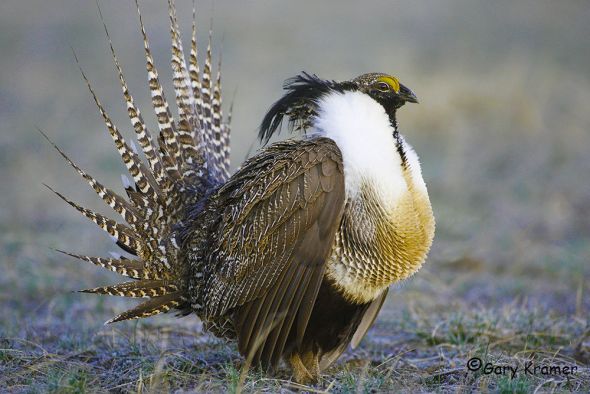
Endangered Species Monday - Centrocercus minimus
Picture credits: Gary Kramer Photography.
This Mondays endangered species article I take a glimpse into one of the planets most endangered bird species and one of the millenniums kind of newest discoveries, or more “an overlooked species should I say”.. The Centrocercus minimus, commonly known as the Gunnison Sage Grouse is the bird I am speaking about and, not the “Greater Sage Grouse”. C. minimus species is listed as (endangered) of which its populations are declining quite extensively. The species was identified back as a “new species” by Dr Mark Young et al 2000 after environmentalists believed the species to be the near threatened Greater Sage Grouse. Thankfully after much research this stunning bird and its non-similarities to the Greater Sage were finally uncovered.
Endemic only the United States population sizes are very, very sparse and limited. From census counts back in 2005 mature individuals stand at a depressing 1,700. This roughly equates to around 2,500-2,600 total individuals if that. If there is one bird within the United States that could benefit from “extreme conservation preservation” C. minimus is one out of several unrelated species requiring immediate protection status.
Conservation actions began back in 2005 of which a working group was formed to protect and oversea all conservation projects of this magnificent bird. Back in 2008 a conservation plan identified over 200 actions that required immediate addressing to stop its sudden decline into extinction. By 2005 over ninety five percent of the population was covered by working groups.
Conservation actions proposed/underway:
Restore and improve habitat, while continuing work to prevent further loss and fragmentation. Support its listing on the Endangered Species Act. Continue population monitoring at key sites. Conduct further ecological research, focusing on survival, dispersal and habitat use at different life stages. Encourage and facilitate the implementation of local and range-wide management plans. Reduce disturbance, especially at active leks. Investigate the possibility of using translocations to augment small populations. Continue work to raise awareness of key issues among stakeholders.
Image: Gunnison Male. Males fan their feathers, strut while popping air sacs in their chests. Males put this show on to attract females. Behavior becomes aggressive when females are present.
Gunnison Sage Grouse are notable for their elaborate courtship rituals. Each spring males congregate on leks and perform a “strutting display”. Groups of females observe these displays and select the most attractive males to mate with. Only a few males do most of the breeding. Males perform on leks for several hours in the early morning and evening during the spring months. Leks are generally open areas adjacent to dense sagebrush stands, and the same lek may be used by grouse for decades.
Threats
Habitat loss, degradation and fragmentation is resulting from conversion to roads, reservoirs, livestock-grazing, hay and other crops, real estate developments, power lines, land treatments and increased deer populations - hence why hunters do participate in seasonal hunting of deer to keep populations in check and from destroying Gunnison Sage Grouse’s habitat.
Many winter sites are directly threatened and being enclosed by urbanization. Severely fragmented populations have low genetic variation and the recent reintroduction of the disease West Nile virus to the species’s range is a concern. Inbreeding depression appears to be occurring due to the skewed mating system at leks: six of the seven extant populations now appear to be low enough to be suffering from this. Disturbance from scientific study and recreational birdwatchers may cause stress and reduced lek attendance and production.
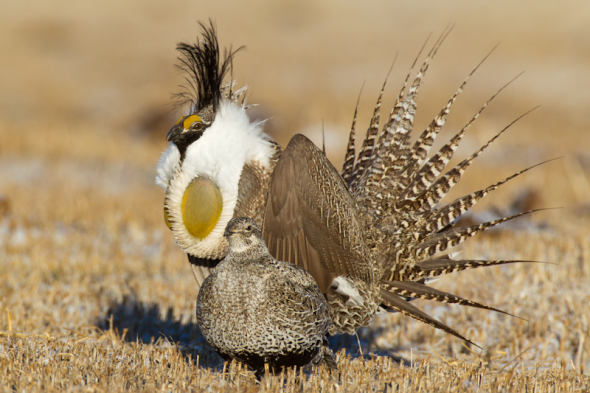
Male Gunnison Sage-Grouse displays on the lek during a spring mating season at Mill Creek Ranch in Gunnison, CO.
Severe winters and potentially droughts may represent survival bottlenecks (e.g. in 1984, less than 10% of sagebrush emerged above the snow as may other habitat factors influencing chick survival. Calls to increase gas prospecting in areas of sagebrush habitat represent a potential future threat.
Hunting has since been banned when the new species was formally identified back in 2000 and conservation actions began. G. Sage Grouse is mostly confined to Colorado with some smaller populations confined to Utah. The species has been recognized by the American Ornithological Union as one of the ten most endangered species of birds in North America. It is therefore listed as a possible candidate for future protection under the Endangered Species Act (ESA). However, while numerous groups have developed conservation plans and actions for the species; it continues to be at significant risk and lacks federal protection under the ESA.
Thank you for reading.
Dr Jose C. Depre.
Chief Environmental and Botanical Officer (CEO)
India: War on Poaching Intensifies.
India: War on Poaching intensifies.
Since early May 2012 the Indian State, Maharashtra government provided all of its rangers a shoot to kill licence directly aimed at “poachers” regardless of age, sex or religion. The shoot to kill order was given of which rangers are immune from prosecution due to high levels of Rhino, Tiger, Lion and, Elephant poaching within the country.
When International Animal Rescue Foundation India became aware of Maharashtra government’s demands they watched and waited for results of which back then were little however, since 2013 rangers have been actively involved in over one hundred and forty nine legal killings with a further eleven so far to date (13th June 2015). The number is believed to be a lot higher. Furthermore as poaching is not just confined to “animals” but also the sacred sandalwood, forestry rangers have been actively engaging sandalwood poachers and smugglers too.
April 4th 2015 forestry rangers and Police came under heavy gunfire in two separate locations within Tamil Nadu, Chittoor. Police and forestry guards tried to apprehend some twenty sandalwood poachers/smugglers of which took off into the sandalwood forests in Andhra Pradesh. The first shoot out saw some saw some nine smugglers shot dead in one area of the sandalwood forest that is unknown to us while a second saw a further eleven smugglers shot dead in what was described as a “heavy exchange” of bullets from both sides within Chittoor in Southern Andhra Pradesh. While some people have stated this action unjust we please ask you to continue to reading (to the bottom) for you to fully understand why the Police and forestry services may have took such action.
2015 has been quite a busy year thus far for forestry rangers and Police. At the start of the year, 15th January 2015 three Rhino poachers that were directly ordered to lay down their weapons aimed them at forestry guards opening fire. The incident that took place in the Kaziranga National Park, in the remote state of Assam prompted forestry guards to act quickly and professionally to preserve the sacred One Horned Rhino of which they shot the three poachers dead instantly. Fortunately no forestry guards or the Rhino were injured this time.
March 2015 a further three ivory poachers that were caught red handed slaughtering an Indian Rhino of which the Indian Rhino lost its life and was left in a pitiful state were shot dead immediately. We’ve included the image of that Rhino below for your information and to grasp why we and India have now had enough of this slaughter and will take the relevant steps required to support our men and women to secure our fauna and flora.
Image: Rhino killed by ivory poachers - poachers shot dead on site.
While poaching continues so does “hunting the poachers too” and so it rightfully should. International Animal Rescue Foundation India supported by its sister Africans Environmental company, began paying five “unnamed” forestry units within the shoot to kill zones larger cash incentives to hunt and take down any mammal or sandalwood poachers. The organisation has come under some fierce criticism from mainly European and American citizens most of which are devout church goers or, believe poverty is the first step that needs to be dealt with.
International Animal Rescue Foundation’s Indian Chief Executive Officer Vasvi Kanal stated “On consulting the Chief Environmental Officer back in 2012 when we were made aware of Maharashtra’s stance we knew we had to do something to support our brave men and women. After a meeting in New Delhi that following summer it was decided we should support the shoot to kill policy to send a a direct message out to poachers that you’ll no longer simply walk into our forests and parks and take what’s not rightfully yours”. Kanal went onto state “The shoot to kill policy had to be endorsed one way or the other and, I thank the Chief Environmental Officer Dr Jose Depre for wiring the funds directly to us that are now placed into the hands of these brave men and women to seek and kill poachers”.
Image: Indian Rhino poacher shot dead on site.
Since the policy was enacted in 2012 in Maharashtra some seven states within India have since followed suite of Maharashtra’s firm stance and, since 2014 we’ve seen a staggering increase of poachers that have been caught trying to kill Rhino, Elephant, Tiger or illegally harvesting sandalwood shot dead on site. Furthermore many Indian press agencies have picked up the organisations support creating debate and stories on the subject that has encouraged more and more female and male citizens to come on board to protect and preserve our natural habitat and sacred heritage.
Soon after Maharashtra’s stance on “all animal and habitat poaching/destruction” took on a new positive twist, Nepal back in 2013 set their Anti Poaching Units into action - to hunt the - hunters. About 10 years ago, when the country was deeply mired in a civil war between government forces and Maoist rebels, there was hardly any focus on wildlife protection in one of Nepal’s most famous parks
The number of army monitoring posts in and around the park was reduced from 30 to seven as soldiers were shifted to anti-insurgency operations. In 2002, about 37 Rhinos were killed by poachers, triggering grave concern over the future of One-Horned Rhinos. Their numbers dropped from an estimated 612 in 2000 to less than 375 in 2005.
“According to our last rhino census in 2011 the number of Rhinos in the park has risen to more than 500,” said Kamal Jung Kunwar, a senior official at the Department of National Parks and Wildlife Conservation.
As the chief of the Anti-Poaching Operation from 2003 to 2007, Mr Kunwar played a key role in the conservation of Rhinos in Chitwan National Park. Spread over an area of more than 930 sq km, the park consists mostly of Sal trees and grasslands. Its flat lowlands are home to a variety of endangered animals like Royal Bengal Tigers, Rhinos, Leopards and Gharial Crocodiles. Crucial re-deployment: The successful conservation effort is attributed to a variety of initiatives, including tough action against poachers, enhanced intelligence and involving villagers living around the park in conservation efforts.
Image: Rhino poacher shot dead.
Meanwhile, while India strides forwards in its tough Anti Poaching operations poachers are still targeting rangers and police leaving their seriously injured on in many cases themselves killed. Deaths continue on both sides and rarely do the press and media overseas bother to print on the bravery of these men and women or, their tragic deaths.
Back in January 2014 poachers killed a female Rhino and a home guard at the Rajiv Gandhi Orang National Park, that Wednesday. Park officials said the home guard, Sushil, was killed during a gun battle with the poachers, who also managed to chop off the Rhino’s horn.
Rifles and ammunition were recovered from the spot. This is the second case of poaching at Orang which has about 100 Rhinos. The last Rhino was killed earlier in December, following which the park authorities announced a cash reward of Rs 50,000 for information on poacher Md Joynaluddin alias Junu. The authorities have also pasted Joynaluddin’s posters at several places in Darrang, Sonitpur, and Morigaon districts.
Back in 2014 a survey was undertaken on the number of rangers that are sadly murdered by poachers and killed by wild animals within the country according to the IBT. The results were shocking of which encouraged International Animal Rescue Foundation India to push more funding into local forestry units around Assam and the Ministry that supports guards financially. India loses more forest/Anti Poaching Guards than any other country on the planet.
Most of the Indian forest security men and women have been killed by poachers and wild animals, states the survey by non-profit organisation International Ranger Federation (IRF). In the past three years, as many as 72 forest rangers died in India, whereas in other countries in Asia, Africa and America, only less than 10 deaths of forest rangers have been reported, The Times of India reported, quoting the survey by IRF which strives to create awareness about forest rangers and security men.
It can be recalled that smugglers of red sanders killed several forest rangers in AP’s Tirumala forests in recent years. Notorious bandit Veerappan has also killed several forest officers and security men till a decade ago. The survey further stated that about 60 percent of the forest rangers’ killings, in the last three years, happened in Asia.
“We are extremely concerned that rangers continue to face high levels of violence and are being murdered at an alarming pace,” said IRF president Sean Willmore.
India lost 24 forest rangers in 2014, 14 in 2013 and 34 in 2012. India tops the list in the deaths of forest rangers during all three years. The report went onto state - That most rangers were killed by wild animals and poachers. Apart from animals and poachers, diseases such as dengue and malaria, forest fires and road accidents have also claimed the lives of rangers, the survey added.
In India, smugglers of wild animals and forest wealth like red sanders do not hesitate to kill rangers, if they are obstructed from committing the crime. In Seshachalam forest of Andhra Pradesh, about 200 smugglers attacked forest rangers and killed two officers in December 2013. The 200 smugglers first rained stones on the ranger sand then attacked them with batons. Rangers in India are often seen unarmed, making them vulnerable to the smugglers’ attacks.
The government of India has been dealing with wildlife poachers with an iron fist in the past one year with 30 poachers being gunned down in the Northeast alone. The number that figured in the data released by the environment ministry is the highest ever in the country. Most of the killings took place in the Kaziranga National Park, Assam. The KNP, Assam is the largest known “active poaching area” hence the largest amount of hits and is custodian to over 1000 endangered Indian one Horned Rhinos.
“The number shows our determination to eliminate wildlife traffickers and poachers. It is a big achievement of the Modi government,” environment minister Prakash Javadekar said recently.
Highly sophisticated arms were recovered from the poachers who killed Rhinos for horns smuggled to South-East Asia through porous Myanmar. Hunting down of poachers in Kharbi Anglong of Assam was undertaken by the Congress-led Assam government to save single-horn rhinos of Kaziranga and nearby areas.
Big cats at huge risk:
Wildlife in other parts of the country isn’t as lucky as the Rhinos. As many as 23 Tigers and 116 Leopards were poached in 2014 across India, with states like Uttarakhand, Maharashtra and Madhya Pradesh reporting a large number of cases.
“These are the cases that have been reported. There might have been cases where the poachers took the whole animal, without leaving a trace,” said Tito Joseph of the Wildlife Protection Society of India. Traffic, a non-government group monitoring wildlife trade, says that there has been no let down in illegal wildlife trade in India. It says the Northeast is turning into a hub of wildlife smuggling.
A report by the National Tiger Conservation Authority also indicates weak wildlife crime management in the country. It states that almost 40% of the forest guards do not have enough equipment to deal with highly organised wildlife crimes. “The states are not providing funds to modernize wildlife crime management,” a senior official said.
Concluding;
Despite some public criticism calling the organisation “dogs” and “disgusting” India’s tough stance on Anti Poaching must continue. International Animal Rescue Foundation India hopes to push a further $15,500 into the cash incentive jar to help equip rangers, police and forest guards. Furthermore the environmental company that has some one people working on the ground in New Delhi will be working with local communities in poverty stricken zones where poachers are known to originate from to help decrease poaching, improve poverty and hopefully decrease killing on both sides.
Lastly I wish to leave you with this video directed at those that believe Indian forestry guards and Anti Poaching Units are randomly picking off innocent people. Please watch the video to the end and undertake your own Google search on those brave men that sadly lost their lives fighting for animal and environmental freedom.
Thank you for reading.
Johan La Roux
Rhino Welfare Project Africa.
Endangered Species Friday - Bos javanicus
Endangered Species Friday - Bos javanicus
“Thus, the hunting is the proximate cause of decline”
Hunters often demand that we prove to them such a sport or just hunting for food say hasn’t ever pushed a species into nearing extinction or extinction within the wild. The Bos javanicus is under threat from hunters and poachers. (image above - female Banteng)
This Friday’s endangered species article we focus our attention on the Banteng as its commonly known identified back in 1823 by Dr Joseph Wilhelm Eduard d’Alton (August 11, 1772 – May 11, 1840). Mr d’Alton was a German engraver and naturalist who was a native of Aquileia (today part of Italy). He was the father of anatomist Johann Samuel Eduard d’Alton (1803–1854).
He studied in Vienna, and later worked in several locations, including Weimar and Jena. Afterwards he moved to Würzburg, where he worked with embryologist Christian Heinrich Pander (1794–1865). He later taught art history and architectural theory at the University of Bonn, where in 1827 he became a “full professor” of art history. From 1831 to 1840, d’Alton was a member of the Prussian Academy of Arts. One of his famous students in Bonn was Karl Marx. ~Wiki.
The Banteng is listed as (endangered) and is endemic to the countries of Cambodia, Indonesia (Bali, Jawa, Kalimantan), Lao People’s Democratic Republic, Malaysia (Peninsular Malaysia - Regionally Extinct, Sabah), Myanmar, Thailand and lastly Viet Nam.
Unfortunately the species is now known to be “regionally extinct” within the countries of Bangladesh, Brunei Darussalam and India. From 1986 to 1994 the species was listed only as (vulnerable) however, due to mass deforestation, poaching, habitat destruction and unregulated hunting not forgetting increasing human population the species has since been listed as (endangered) from 1996 to 2000.
Recent surveys have since established where localized extinctions have occurred (listed above). Furthermore new observations of this rather unique and stunning wild cattle is still considered to be (endangered) despite new evidence of increasing populations emerging in Thailand.
The species historically occurred throughout China in the Yunnan province. Historical data proves the Banteng was present within the Peninsular Malaysia to the islands of Borneo, Java, and probably Bali (please note that in Bali both domestic and wild cattle are known to coexist).
There is no evidence that the species originated from Bali due to there being no fossil evidence being located thus far. Some “populations” on the island are therefore classified as (domestic) rather than all wild. A point of concern has been noted from Dr Watling that quoted “interbreeding with domestic Bali cattle is a problem and the population is unlikely to consist solely of pure-bred animals”. Dr Wind and Dr Amir had earlier raised similar fears too back in 1977.
The species known to inhabit the island of Bali was introduced and did not originate as explained above. Furthermore the “domestic” Banteng have been introduced into Sulawesi, Sumbawa, and Sumba. Feral Banteng occur in Kalimantan. Introduced Banteng (probably feral animals) occurs on the Indonesian islands of Enggano (off Sumatra) and Sangihe (off Sulawesi).
Domestic Banteng has also been introduced to New Guinea and Australia and there are now large feral herds in the Northern Territory. One may have noticed in local Australian hunting magazines, online or within farms in the Northern Territory hunters now paying large sums of money to kill and trophy mount the species within their homes. Despite the “wild” populations suffering and nearing extinction little money from such hunting projects is even provided to conservation organisations and local communities to preserve the species within its native habitat.
Image: Male Banteng Bull (Males are mostly black whereas females are brown)
Wild Banteng are known to live on the island of Bali (please remember not to confuse domestic with wild populations). Furthermore wild Banteng are known to inhabit the island of Java, Kalimantan [Indonesian Borneo], Sabah (although in Sabah extinctions have been noted but not as yet fully confirmed).
A few populations remain in Sarawak however the species is completely extinct within Brunei. Banteng are extinct within Bangladesh and, in India. There are some conflicting reports that the species never even existed within Manipur (northern India - to note).
Extinctions have occurred sadly in Western Malaysia since the 1950’s. southeast Yunnan around Tongbiguan Nature Reserve, along the border with Myanmar; however, the source for this is unclear; and presence in China should be considered tentative at best. Its quite likely the Banteng in China is extinct too however this must not be taken as confirmed. We remain open on this case until further proof is made available of populations being present within the range as explained above.
The species is still wildly inhabiting within Cambodia, Cardamoms Mountain range, with the bulk of the population remaining in the eastern forests, centered on Mondulkiri Province.
The entire “worlds” population is said to be no fewer than 8,000 mature individuals however could be no fewer than 5,000 if that. In Cambodia, Banteng probably declined by 90% . Listed on Cites Appendix II population trends are declining rapidly despite the fact there are some four sub-species and the largest strong hold of sub-populations is on the island of Java.
Threats
The major threats to Banteng are hunting and habitat loss. In Sabah habitat loss to permanent agriculture is a serious threat, although hunting is equally significant and the species has been rapidly exterminated from many areas there. Habitat loss has also been serious in Java since 1998. Elsewhere, hunting is the most widespread and significant threat, and is exacerbated especially in mainland Southeast Asia by human repopulation of lowland forest areas and associated habitat fragmentation, that is, the very areas where most Bantengs occur.
Image: Domestic Banteng are hung to death every year within Baojiang, Rongshui, Guangxi China. The ceremony is yet another listed threat to the species as it also includes wild Banteng that the locals “and foreign tourists” consider non-cruel, a tradition that’s been ongoing for over 500 years. Wild Banteng are considered more important than domestic - of which places a considerable threat to the population despite some conflicting evidence that wild Banteng populations and few and little within China. Nevertheless the species is under immense threat.
Although huge tracts of suitable habitat were lost in the twentieth century, and continue to be converted, this has probably largely occurred after Banteng have been hunted out. Thus, the hunting is the proximate cause of decline, but habitat loss is continually reducing the maximum population possible if hunting issues were to be controlled.
The magnitude of the threat posed to Banteng by international trade in trophy horns is difficult to quantify. Nevertheless, given the small size of the remaining Banteng population and the number of trophies found for sale in Cambodia, the Lao PDR, Thailand, and Viet Nam, during what were essentially opportunistic surveys, it is clearly a major threat on the Asian mainland. The threat posed by use of traditional medicinal substances derived from wild oxen is even harder to determine in the case of Banteng and essentially remains unknown, although it is thought to be a source of significant threat to Gaur.
The most important population in Cambodia is scattered through a forest landscape that encompasses four provinces (Mondulkiri, Kratie, Stung Treng and Ratanakiri) and five conservation areas (Lomphat Wildlife Sanctuary, Phnom Prich Wildlife Sanctuary, Siema Biodiversity Conservation Area, Mondulkiri Protection Forest (including the Srepok Wilderness Area) and Phnom Nam Lyr Wildlife Sanctuary).
Hunting is still rife in much of this area, and forest fragmentation is rapidly accelerating with human population in-migration, infrastructural developments (especially roads), commercial agricultural expansion, economic land speculation and mineral extraction. However, although perhaps less than 20% of this area is well protected from the aforementioned threats and protected area management is only close to effective in two areas, the most significant issue concerning the area is the long-term uncertainty of continuation of effective conservation management of the Srepok Wilderness Area and Siema Biodiversity Conservation Area.
Although conservation efforts for Banteng and many other species have been, in both areas, extremely encouraging for the last few years, both areas face an uncertain future with the possibility of de-gazettment of conservation status of parts of them, the possible loss of adequate external funding necessary to maintain high standards of management, the possible loss of political support necessary to uphold high protection standards and the uncertainties of maintaining a motivated and well-trained staff.
On Java some populations are potentially threatened by heavy predation from Dholes Cuon alphinus (a species I spoke about this Monday). All populations are also threatened by poaching and some, perhaps most, are threatened by habitat loss and degradation. During the 1980s–1990s, when poaching and land conversion were relatively well under control in Javan national parks, the chief threat to the large population of Banteng in Baluran National Park was loss of grazing area to invasion by the introduced tree Acacia nilotica (Leguminosae) that converts open grassland to dense thorny scrub-forest.
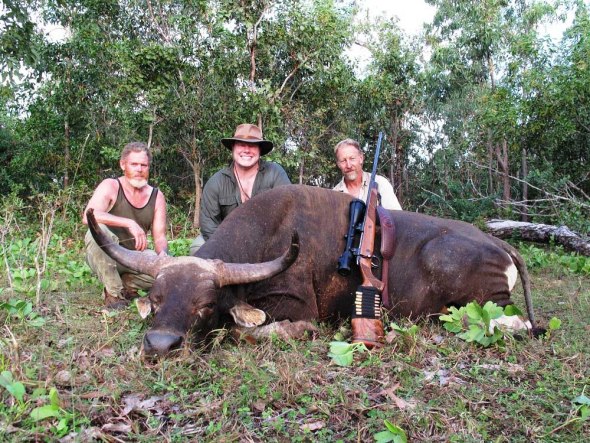
Image: Introduced into Australia in the last century the species is hunted for sport despite the species being listed as endangered within its native range - very little money is raised for preservation of the species within Australasia. Hunting remains outside of Australia as the major number number one threat pushing the species and sub-species into more decline.
This plant was introduced (without adequate risk assessment) as part of an attempt to create a living fire-break around the park’s grasslands, wild fire then being adjudged the major threat to the park’s monsoon forests. Since that introduction, repeated cutting of the acacia has led to coppicing into very dense thickets that contain little or no grass or other herbs and are difficult for the cattle to penetrate. Thus habitat loss and poaching are now serious limiting factors in Baluran National Park, and habitat loss/degradation remains a severe long-term threat to be addressed. Lantana camara (Verbenaceae) is also a problem in Banteng habitat in Baluran National Park and elsewhere on Java.
Bali cattle have long been interbred with other cattle: Banteng and Bali cattle can interbreed with both common cattle and mithan (Bos frontalis). Hybrids between Banteng and common cattle (Bos Taurus) of the zebu type are fully fertile; in hybrids between Banteng and Bos Taurus of the European type the males are sterile. Domestic and feral livestock are thus a potential threat to the genetic integrity of wild Banteng populations and a number of reports suggest that wild Banteng does interbreed with domestic cattle.
For example, Hoogerwerf (1970) referred to several sources from the 1930s and 1940s which mention that many groups of Banteng in Kalimantan (particularly East Kalimantan) were no longer pure-bred having interbred with stray domestic cattle. Wharton (1957) also found evidence of interbreeding with domestic cattle in Cambodia; and reports from Myanmar mention that Banteng feed alongside village cattle and occasionally interbreed with them.
In addition to the genetic threat, domestic livestock are a potential source of diseases and parasites. This can have very serious consequences for Banteng which appear to be particularly susceptible to a number of cattle diseases; for example, Banteng populations in Myanmar have been very badly affected by diseases from domestic cattle.
Introgression with domestic cattle is not presently an issue in Sabah; there have been imports of Bali cattle mostly by large cattle farms who house animals in feedlots away from wild populations. Ahmad AH is unaware of any instances of deliberate introduction of Bali cattle or other domestic oxen into forest areas, or of any plantation holders that have deliberately introduced their cattle into the range of wild Banteng. Although integration of livestock into oil palm plantation has been discussed for many years, this has not yet been put into practice.
In all due respects its quite likely were going to lose the species due to unregulated hunting, controlled over hunting, poaching, traditional medicine trade, habitat destruction and fragmentation, land conversion and agriculture.
Video: Female Banteng
Thank you for reading.
Dr Jose C. Depre
With thanks and much appreciation to the Environmental Team at - International Animal Rescue Foundation Asia.
Revelation 16:16 Har-Ma ged’on or Human Fault?
Revelation 16:16 Har-Ma ged’on or Human Fault?
Since 2000 International Animal Rescue Foundation has been following, reporting and researching mass animal deaths around the globe and (some) freak unexplained deaths that have left scientists baffled. Furthermore the increasing avian bird flu pandemic that is threatening many birds and dogs looks set to be the largest outbreak in history.
Some of the worst cases we and the I.A.R.F have viewed are unexplained whale, seal and dolphin beaching’s all of which have been occurring along coastlines and within local fresh water rivers. Pollution has been the main number one factor blamed for many land and marine deaths. However other deaths have left ourselves and scientists puzzled as to why many animals have been found dead in large piles, what has led to such large numbers of animals dying off and how can such large die offs be prevented?
The vast majority of animal deaths seem to be occurring within Asia and the United States. Research has shown that there is no real limited location in either the United States or Asia. 8th June 2015 in Florida hundreds of dead fish washed up onto the local shoreline. A few days prior to this a large fish kill in a lake in Mattoon, Illinois was witnessed. Meanwhile in Lake Aldama, Mexico 3rd June 2015 tons of fish were located dead floating on the surface in what has been stated as “unexplained mass deaths”.
Image: 2 waterways that will host 2016 Olympic events in Brazil are filled with dead fish and trash 16 months before the games.
Within the past twenty eight days hundreds of dead fish appeared in the waters of Michoacan, Mexico. Hundreds of dead fish were found washed up along Big Bear Lake in California, America. Meanwhile thousands of dead fish were found washed ashore on a river in Rhode Island. 30th May 2015 tens of thousands of dead fish were found washed up along Flanders bay, New York.
Environmental teams from International Animal Rescue Foundation Scotland, England and France have also reported and viewed with dismay mass die offs and stranding’s off the British, Scottish and French coastlines too. 2nd June 2015 - 21 pilot whales were located stranded, ten of which were reported dead in Skye, Scotland. Within Rennes, France a large die off, of fish was witnessed in the River close to Rennes. 27th may 2015 hundreds of fish were located in the River Darlinton, Great Britain. On the 23rd April “thousands” of dead star fish were located off the coast in Cumbria, Great Britain and, on the 17th April 2015 “scores” of dead “dolphins and whales” were found washed up on the along the coast of France in what scientists state as “strange” and “unexplained”.
Image: Ireland, Lissadell Beach, Co Sligo, strewn with dead starfish.
There are many explanations as to why so many marine and fresh water animals have been found dead most of which are put down to chronic pollution, whales and dolphins colliding with marine vessels, changes in ocean temperatures, earthquakes down to environmental changes and, sonar operations by naval forces. Some marine experts and Animal Activists have blamed military operations within the seas and close to land. Conspiracy theorists are blaming secretive governmental organisations and operations while religious individuals are stating the time is coming 16:16 Har-Ma ged’on. Environmental scientists have found neither evidence of mass animal deaths caused by covert government operations or Har-Ma ged’on nearing.
Conspiracy theorists and religious individuals need to put their suspicions and beliefs to one-side and concentrate on the more realistic issue which is that of human blame. Meanwhile, while there is evidence to prove that human activity and negligence is to blame it must be noted too the “unexplained events” that still cannot be answered are a cause for concern and need more in-depth investigations.
Image: Pilot whales stranded off the coast of Scotland, Skye. Nine died.
Below I have included three major culprits that International Animal Rescue Foundation’s Marine Department have been investigating since 2000. While these three culprits remain major players one must not forget aggressors such as climate change of which reveals little evidence on mass marine deaths and deliberate or accidental damage such as oil spillage or vessel waste dumping out at sea. Below and for your information is collated research in word format and video evidence too. If you’d like to discuss this matter further please do not hesitate in contacting myself or anyone of my team here at: [email protected]
Red Tide: Algae Bloom/ Red Tide.
Image: Red tide (HAB) Harmful Agal Bloom of the coast, Sydney Australia.
An algal bloom is a rapid increase or accumulation in the population of algae (typically microscopic) in a water system. Cyanobacteria blooms are often called blue-green algae. Algal blooms may occur in freshwater as well as marine environments. International Animal Rescue Foundation’s Marine Department has located much evidence of such algal blooms responsible for mass fish and whale deaths.
Of particular note are harmful algal blooms (HABs), which are algal bloom events involving toxic or otherwise harmful phytoplankton such as dinoflagellates of the genus Alexandrium and Karenia, or diatoms of the genus Pseudo-nitzschia. Such blooms often take on a red or brown hue and are known colloquially as red tides.
During the 13th May 2015 reports of many hundreds of Diamondback Terrapins were reported within Flanders Bay. Marine scientists have stated that saxitoxin is to blame for the mass animal deaths however the jury is still out on this issue. I must also note that Flanders Bay has in the past six months been the main focus of attention for marine biologists as hundreds and hundreds of dead marine life has been found washing up within the area with no real explanation.
Saxitoxin (STX) is the best-known paralytic shellfish toxin (PST). Ingestion of saxitoxin (usually through shellfish contaminated by toxic algal blooms) is responsible for the human illness known as paralytic shellfish poisoning (PSP).
The term saxitoxin originates from the species name of the butter clam (Saxidomus giganteus) in which it was first recognized. But, the term saxitoxin can also refer to the entire suite of related neurotoxins (known collectively as “saxitoxins”) produced by these microorganisms, which include pure saxitoxin (STX), neosaxitoxin (NSTX), gonyautoxins (GTX) and decarbamoylsaxitoxin (dcSTX).
Saxitoxin has a large environmental and economic impact, as its detection in shellfish such as mussels, clams and scallops frequently leads to closures of commercial and recreational shellfish harvesting, especially in California, Oregon, Washington, and New England. On researching current marine deaths in the California state of America I must note that Saxitoxin and human induced environmental change has been noted as causing the deaths of many seals and fish. The local seal deaths must not be confused with pollution or Saxitoxin but more increasing water temperature that is forcing fish further away from the shoreline. Due to mother seals having to fish further afield their cubs are being left for longer periods thus starving practically to death.
International Animal Rescue Foundation found quite alarming evidence of Saxitoxin an incredibly potent and toxic chemical known to be used within the armed forces as a “suicide pill” freely on sale via a quick and easy Google search. The Ead department furthermore located members of the public asking where they could obtain such a harmful chemical of which should only be handled by (experienced chemical professionals).
Back in August 2003 Saxitoxin was to blame for the deaths of many humback whales. The deadly alga was the leading suspect in the mass death of humpback whales around 150 miles off Cape Cod, say marine experts.
Carcass sightings suggest that at least 12 whales, mostly humpbacks, have died in the Georges Bank area, making it one of the worst known mass fatalities. “It’s really quite disturbing,” says whale biologist Phillip Clapham of the Northeast Fisheries Science Center in Woods Hole, Massachusetts.
A red tide of the toxic algae Alexandrium fundyense is the most likely culprit. The algae’s poison, saxitoxin, killed 14 whales in the same area in 1987. Saxitoxin can accumulate in mackerel which whales eat. Scientists did also point to a very slim chance of acoustic operations conducted at sea by the Navy.
International Animal Rescue Foundation has found Saxitoxin to be the main culprit thus far related to fish, whale, seal and other marine deaths. Saxitoxin has been blamed for the recent unexplained deaths of thousands of lobsters within California this past month too.
Could it also be a sheer coincidence that all deaths seen within Asia, United States and South America are somehow related to “Saxitoxin” and not religious events, the rebirth of Jesus Christ or covert military operations?
STX is a neurotoxin naturally produced by certain species of marine dinoflagellates (Alexandrium sp., Gymnodinium sp., Pyrodinium sp.) and cyanobacteria (Anabaena sp., some Aphanizomenon spp., Cylindrospermopsis sp., Lyngbya sp., Planktothrix sp.)
STX has been found in at least 12 marine puffer fish species in Asia and one freshwater fish tilapia in Brazil. However, the ultimate source of STX is often still uncertain. In the United States, paralytic shellfish poisoning is limited to New England and the West Coast. The dinoflagellate Pyrodinium bahamense is the source of STX found in Florida.
Recent research shows the detection of STX in the skin, muscle, viscera, and gonads of “Indian River Lagoon” southern puffer fish, with the highest concentration (22,104 μg STX eq/100 g tissue) measured in the ovaries. Even after a year of captivity, the skin mucus remained highly toxic. The various concentrations in puffer fish from the United States are similar to those found in the Philippines, Thailand, Japan, and South American countries. Coincidentally all of these countries have the “largest” amount of fish and whale die offs. However I must note that my mere speculation must not be taken for an answer.
Pollution: Human Negligence.
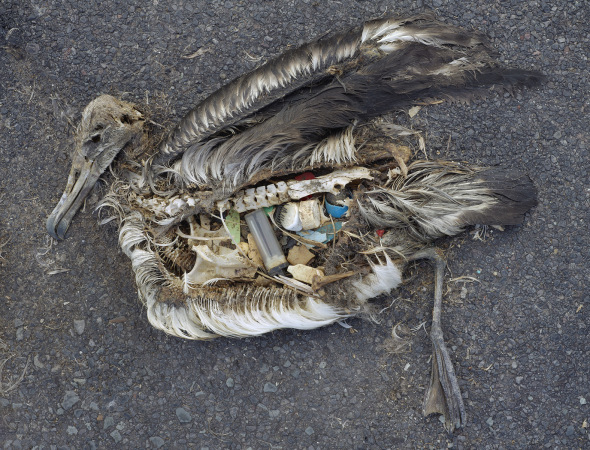
Image: Shocking - stomach contents of a dead Albatross.
I’m a great lover of birds and viewing this image has distressed myself countless times. Daily I ask why do we as humans treat our planet like a dumping ground of which animals suffer dearly.
While Mother Nature is naturally attacking herself we must not forget that human negligence is overall the biggest culprit known to be causing countless marine and fresh water animal deaths. Pollution increases as human population does and a colossal lump of everyday natural and man-made human waste sadly does end up within fresh and marine waters.
10th January 2015 the Environment Agency in Leicestershire, United Kingdom blamed human pollution for causing the deaths of “thousands of fresh water fish”. Farm slurry was the main culprit here of which the Environmental Agency concluded within their report as the main culprit.
Waterway manager for the trust, Neil Owen, said: “It’s really sad that we’ve had so many fish die from the careless actions of an individual which allowed slurry to enter our waterway. The end count was said to be “60,000” fish dead due to one ignorant and unprofessional action of a single farmer.
Meanwhile this past April tons of dead fish have been removed from a Rio de Janeiro lagoon where Olympic events are to be held in 2016, sparking debate among officials and scientists over what caused the mass die-off, as well as fears that the water may be unsafe for athletes.
The die-offs are becoming a common occurrence in Rio, where rivers, lakes and even the ocean are blighted by raw sewage and garbage. Officials have argued over the cause, with Rio’s environmental secretariat insisting last week that the incident is the result of the sudden change in water temperature.
“The intense rains that happened last week and a rise in the sea levels led to a spike in the [sea] water entering the lake, causing a thermal shock,” the secretariat said in a statement, adding that the water temperature had fallen by 7.2 degrees Fahrenheit in a short period of time. Many scientists disagreed with that explanation, pointing to pollution instead.
January 12th 1988 pollution was blamed for the deaths of countless scores of beluga whales. Autopsies of dead belugas washed onto the banks of the river have found very high levels of more than 30 hazardous chemical pollutants, including DDT, polychlorinated biphenyls or PCB’s, the pesticide Mirex, metals such as mercury and cadmium, and polycyclic aromatic hydrocarbons similar to those found in cigarettes and regarded as cancer-causing agents.
The diseases found in the 72 dead whales examined so far include bronchial pneumonia, hepatitis, perforated gastric ulcers, pulmonary abscesses and even a case of bladder cancer. A majority of the whales appear to have died from septicemia, or blood poisoning, which killed them because their immune systems failed.
While the above report dates back to the last century one would be led to believe that governing bodies would have at least (cleaned their act up). Unfortunately that is not the case. In August of 2014, biologists from the Virginia Aquarium and Marine Science Center Standing Response Team were notified of a particularly unusual sighting regarding a long young female sei whale. She was spotted swimming up the river, which is particularly unusual as these creatures are typically found in the deep waters of the Atlantic.
A necropsy revealed that the whale had swallowed a shard of rigid, black plastic that had lacerated its stomach and prevented it from eating. They found that she had also been struck by a ship. The shard of black plastic was later found to be a discarded DVD case.
To date International Animal Rescue Foundation has uncovered much evidence of marine pollution responsible for the deaths of small and larger fish down to entire shoals of fish and pods of dolphins. Plastic, carrier bags, oil and chemical pollution all reign in at number one and not the Coming of the new Jesus Christ or even a (not so) secret government operation aimed at killing humans and our precious wildlife. Think about it for a brief minute. Why would the United States (E.g) wish to kill hundreds of thousands of fish off when fish is a staple diet and major import and export monetary gain?
Naval Marine Operations: Acoustics.
Image: Whale death caused by naval sonar operations.
Despite natural events and pollution being the major two factors here there still remains yet another problem within our oceans that is angering Animal Activists, Marine Biologists and other experts. Acoustic activities, drilling and military marine operations reign in at number three.
Despite many reports and scholarship articles by leading scientists and marine agencies sounding the alarm acoustic disturbance has been noted and reported to be killing, injuring or seriously impacting on the physical health of whales, fish and crustaceans for some years. Sonars used by international military navy vessels from around the world are giving scientists somewhat of a headache - and - stopping such operations within the deep seas is also another problem especially when sonars are required in all but most of the naval vessels.
Back in 1963 of the Gulf of Genoa, Italy Naval Sonar (NS) operations led to the stranding of 15 Cuvier’s beaked whales (cause - naval maneuvers). Back in 1998 in the Canary islands +12 Cuvier’s beaked whales stranded with a further Gervais’ beaked whale stranding too (cause - FLOTA 88 naval exercise). Back in 2003 the following - Cuvier’s beaked whale (9), Blainville’s beaked whale (3), beaked whale spp (2), Minke whale (2), Atlantic spotted dolphin (1) all stranded, (cause - Naval MFA operation).
One of the very worst cases researched on was seen in Marion Bay, Tasmania where some 145 Long finned Pilot Whales stranded themselves, (cause - “suspected” use of sonar by two naval mine sweepers). Back in 2008 some 26 dolphins stranded themselves off the coast of Cornwall, Great Britain, (cause - Naval exercise but no ship sonar in use except HF hydrographic sonar on HMS Enterprise).
Three of the most commonly seen culprits have been included within this article for your information. Unfortunately while we are aware of these culprits more and more whales, fish and smaller sea creatures are washing up dead around the planet. While some cases cannot be answered due to unknown and non-investigated causes the vast majority of mass animal deaths eventually do indicate - humans as the major player while, natural events such as blooms come second and pollution ranking in at first (Still no evidence of a re-birth of Jesus Christ or the world ending though). Our seas like our lands and airways are becoming more and more congested and with each increase of human activity seen, more and more deaths of both land and marine animals will come.
International Animal Rescue Foundation has located no hard hitting evidence that proves the world is nearing an end, a re-birth of Jesus, Armageddon style apocalypse or (not so) secret military operations responsible for the deaths of many marine, fresh water and land animals.. However while the organisation can rule out a new Jesus re-birth and events written into religious scripture there does remain some suspicion surrounding the High Frequency Active Auroral Research Program or, commonly known as - (HAARP). However any such investigative studies on the (HAARP) program have been quashed as the program will be shutting down after informing Congress last year (2014) that funds needed to be used elsewhere on other weather modification programs. In reality the program is just entering a new phase
Concluding:
We are Mother Natures worst enemy and not any entity within a religious or conspiracy theorists scripture. Humans are polluting the atmosphere, littering the oceans and land, destroying natural habitat, over-populating, displacing animals, killing marine animals through the use of naval exercises and on, and on, and on.
Some people need to look beyond the computer, the conspiracy field of nonsense, religious dates and begin laying the blame at their own two feet. Failing this many more marine creatures and animals will subsequently perish.
Thank you for reading.
Dr Jose C. Depre.
Endangered Species Monday: Cuon alpinus.
Endangered Species Monday - Cuon alpinus.
Dhole - Reckless and Daring.
This Monday’s endangered species article we focus on a rather undocumented species of wild dog in the family of canidae generically identified as the Cuon alpinus back in 1811 and commonly named as Asiatic wild dog, Indian wild dog or just Red dog.
The species was scientifically named by Berlin born Dr Peter Simon Pallas (22 September 1741 – 8 September 1811) was a German zoologist and botanist who worked in Russia. A number of animals were described by Pallas, and his surname is included in their common names, including: Pallas’s cat, Pallas’s long-tongued bat, Pallas’s tube-nosed bat, Pallas’s squirrel, Pallas’s leaf warbler, Pallas’s cormorant, Pallas’s fish-eagle, Pallas’s gull, Pallas’s sandgrouse, Pallas’s rosefinch, and Pallas’s grasshopper warbler. Also, he is honored in the specific epithet of scientific names of animals described by others, including: Pallas’s pika (Ochotona pallasi), Pallas’s reed bunting (Emberiza pallasi), and Pacific herring (Clupea pallasii). (Wiki).
The Dhole is currently listed as (endangered) of which its populations are still decreasing quite rampantly. Although declines are still being documented the species remains native to Bangladesh, Bhutan, Cambodia, China, India, Indonesia, Kazakhstan, Kyrgyzstan, Lao People’s Democratic Republic, Malaysia, Mongolia, Myanmar, Nepal, Russian Federation, Tajikistan, Thailand and finally Viet Nam.
Within central eastern Asia there still remains no confirmed reports of Dhole populations of which the species was once endemic to this range. However as the species has yet to be declared extinct within countries of eastern Asia we must continue to make public that the species may still be true to this region of south east Asia. Recent reports have stated the species was seen within Jiangxi district, south China, however, outside of this area no other confirmed sightings have been noted now for some years within the Tian-Shan Range.
Few sketchy reports have vaguely confirmed that the species was seen (2006) Qilian Shan in north-western Gansu Province. Meanwhile the Dhole still remains within Tibet of which forestry officers and locals confirm the species as “commonly viewed” which is at least a positive note despite populations declines over much of the species endemic range. North Korea was once known to hold Dholes however due to the communist states strict rules and no-go-areas its difficult to document or research on the species. If North Korea does indeed hold Dholes environmental research teams must be granted entry to secure the species from any localized extinction occurring.
South of the River Ganges, India Dholes are still very commonly viewed despite large human population increases, species displacement, human species conflict and, habitat fragmentation. Central, eastern and western India Dholes are still known to inhabit again, commonly. Research teams continue to pick the species up within north eastern India in the states of Arunachal Pradesh, Assam, Meghalaya, and West Bengal too. Further reports place the species within the Ladakh area of Kashmir, which is contiguous with the Tibetan highlands in China.
In Bhutan, there have been recent press reports that Dholes have recovered from a government-initiated mass poisoning campaign in the 1970s and there have apparently been numerous recent incidents of Dholes killing livestock in the lower Kheng region. Two recent, independent, eye-witness reports identify Dholes in six protected areas in Bhutan. In some regions, Dhole predation on wild boar (Sus scrofa) may be viewed in a positive light by local people. Wild boars are known to injure and in some cases fatally wound the locals.
Reports still cannot confirm if the species is present within Bangladesh. In Indochina, Dholes probably ranged over all or almost all of Lao PDR, Cambodia, Viet Nam and Thailand, although reliable site-specific information is scarce. Present distribution is highly fragmented and large parts, particularly of Viet Nam and Thailand, are without any regular occurrence of Dholes, although they persist in a number of protected areas.
The species’ historical range probably included all or most of the Malaysian peninsula and the Indonesian islands of Sumatra and Java, but reliable information is scarce. Current distribution is poorly known but is thought to be highly fragmented. On the Malaysian peninsula, Dholes are known to occur in four sites in northern and central areas of the peninsula (from recent camera-trap surveys). On Java, Dholes appear to be most common in the protected areas at the eastern and western ends of the island. On Sumatra, very little is known, but Dholes are known to occur in major protected areas in the southern, central, and northern parts of the island (e.g., from camera trapping).. There is no reliable evidence of the presence of Dhole in Turkey.
Within some areas Dholes are known to inhabit the same areas as Tigers and Leopards however, due to increasing poaching attacks these areas are not being made public. Its quite likely though that poachers may use the Dhole as a point of interest to illegally monitor and poach Tigers and Leopards. Competition between the Dhole, Leopard and Tiger is mostly avoided due to differences in prey. Some reports have been duly noted of Dholes actually attacking Tigers causing them considerable damage and in two known cases Dhole packs have been documented as killing Tigers.
One would be led to believe that the Tiger has no real predators however, when a Dhole or Dhole pack confronts a Tiger the Tiger will on most occasions retreat up a tree or high rocky incline. Dholes are known to “mob” Tigers for a considerable time should they feel threatened or malnourished. Reports have shown that Dholes are more than able to fend off Tigers and in most cases will if threatened or in search of food maim or fatally wound the Tiger. Dholes are quite able to defend themselves too and have the canines to easily kill and take on Tigers in Tiger habitat. Interactions between the Dhole, Tiger and Leopard has been documented however very little eye accounts or video footage show such species species conflict.
One of the very earliest reports of “Indian wild dogs” attacking Tigers can be viewed below for your immediate attention and information.
Image: A Tiger Hunted by Wild Dogs (1807) by Samuel Howitt. This is one of the first illustrations of the species, featured in Thomas Williamson’s Oriental Field Sports. The depiction though is based on Williamson’s description of the animal as resembling the Indian pariah dog.
Threats
Depletion of prey base: Across almost all of Cambodia, Lao PDR, and Viet Nam, as well as within protected areas, ungulates occur at levels well below natural. All species of ungulate except muntjacs, pigs, and in some areas southern serow (Naemorhedus sumatraensis) are ecologically or fully extinct across extensive parts of the region. Only a few of the largest wildernesses support nearly intact species assemblages and even in these, the larger species (Bos spp., Cervus spp., hog deer Axis porcinus) are very rare.
This situation will likely hinder any possibility of recovery by the region’s Dhole populations, even if the other issues could be addressed. While not as depressed as in Indochina, prey levels in Indonesia also exist at levels much below carrying capacity (because of illegal hunting and habitat degradation). In protected areas in southern and central India, where Dhole numbers are stable, prey densities are high. In north-east India, prey densities are very low in protected areas with Dholes.
Habitat loss and transformation: Currently, extensive areas of natural or semi-natural vegetation remain in Lao PDR and Cambodia, some areas encompassing many hundreds of square kilometres of potential Dhole habitat. However, habitat conversion and fragmentation are proceeding apace. In Viet Nam, very few natural areas of over 50 km² remain. Habitat loss and fragmentation is a major threat to protected areas in Indonesia, particularly those on Sumatra. Habitat loss and degradation are also serious threats to Dholes in South Asia and the disappearance of Dholes from many of the forested tracts in India has been attributed in large part to loss of habitat.
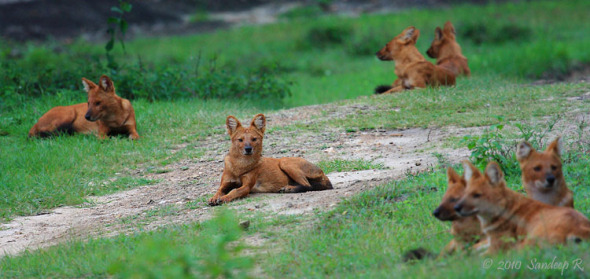
Persecution: This certainly occurs in Indochina, although it is unclear how often. In Indonesia, too, it is a threat but again its significance is unknown. In India, such persecution can play a serious role in limiting local populations. Dholes living outside or on the edge of core protected areas are particularly vulnerable to human kleptoparasitism, snaring (non-selective) and direct persecution. For example, during a radio-tracking study in 2000, in the buffer zone of Kanha Tiger Reserve, central India, at least 16 out of 24 Dholes in one pack died from a sudden strychnine poisoning. In southern India, such persecution is moderate to low and often occurs indirectly when cattle graziers and others inadvertently go close to Dhole dens and disturb adults and pups, disrupting breeding and rearing. “By-catch” in snares and other traps is probably a significant threat to Dholes across Indochina at least.
Competition with other species: Apparently, free-living dogs have been seen and/or camera trapped in many parts of Indochina, but there is no evidence for existence of large populations. Undoubtedly, the main competitor for prey species in Indochina is people. There is no evidence that feral dogs are significant competitors with Dholes in Indonesia. In many parts of their range, Dholes are sympatric with Tigers and Leopards and so the potential for significant interspecific competition for prey exists, especially if the prey populations are reduced as a result of hunting by people.
Disease and pathogens: Particularly those transmitted by feral and/or domestic dogs (e.g., mange, canine distemper, parvovirus and rabies). The significance of disease is unclear in Indochina, but diseases are a significant threat in South Asia and probably in parts of Indonesia. There is no widespread exploitation for fur or other purposes, though medicinal use should be investigated in China..
Thank you for reading.
Dr Jose C. Depre
Chief Environmental and Botanical Environmentalist (CEO)
www.speakupforthevoiceless.org
www.saynotodogmeat.net
www.saynotodogmeatevents.info
www.international-animalrescue-foundation.org.uk
Endangered Species Friday: Anas bernieri.
Endangered Species Friday - Anas bernieri
This Friday’s endangered species article I focus on my eighteenth “Madagascan” species of wildlife since establishing International Animal Rescue Foundation’s Endangered Species Watch Post one and half years ago. I very much doubt too that this will by mine or the teams last such species of Madagascan native animal to print on nearing extinction, simply because the island is rapidly being overcome by humans, habitat destruction and poaching.
Endemic only to the Africans island of Madagascar the the A. bernieri as the species is scientifically known was primarily identified back in 1860 by Dr Karel Johan Gustav Hartlaub (8 November 1814 – 29 November 1900) was a German physician and ornithologist.
Dr Hartlaub was born in Bremen, and studied at Bonn and Berlin before graduating in medicine at Göttingen. In 1840, he began to study and collect exotic birds, which he donated to the Bremen Natural History Museum. He described some of these species for the first time. Dr Hartlaub has been described by many leading ornithologists as an expert in bird wildlife and conservation and, has been ranked as one of few such experts that has identified over hundreds species of birds globally.
Listed as (endangered) the species is commonly known as the Bernier’s Teal or just Madagascar Teal. The species is uncommonly viewed within western Madagascar of which it can be found along the western coast and, north east. Bernier’s Teal is known to breed at the Menabe and Melaky on the central west coast, and at Ankazomborona on the far north-west coast. Between July and August (1993) the species was observed at Antsalova and Morondava of which a census recorded a total of some 200-300 mature individuals. Back in 1998 a small flock was observed in Tambohorano totaling some 60-70 mature individuals.
Furthermore in 1998 a new a new breeding colony numbering some 200-300 mature individuals was recorded in Ankazomborona. Meanwhile the population noted at Baie de la Mahajamba was estimated to be between some 100-200 mature individuals. (Please note that due to lack of census counts and close monitoring these population numbers above may differ from any future or now census counts) however the Durrel Wildlife Conservation Trust is helping to preserve one of the worlds most incredibly rare birds.
The total mean population count of which could be lower than the last census undertaken back in 2007 stands at a pathetic and measly 1,200 to 1,700 mature individuals today. However due to mass deforestation, pollution, habitat fragmentation and destruction and, poaching, Etc, its quite possible populations of the A. bernieri have plummeted way below the last 2002 and 2007 census count.
The Madagascar Teal is of the Anas genus and is a dabbling duck. Huge areas of wetlands are being drained or altered for human activities such as farmland, rice paddies and prawn ponds. Their wooded habitat is also being destroyed for timber which effects their breeding. Due to the increase of humans in their area, hunting has also increased for so called sport and meat.
Threats
Listed on (Cites) Convention on International Trade of Endangered Species Wild Flora and Fauna the species is listed on Appendix II of which is threatened by a large number of mostly human threats. The species is now extremely threatened throughout its breeding range, by extensive habitat loss and disturbance. The distribution of known sites suggests that the single subpopulation is being fragmented as areas of habitat become unsuitable.
The species has limited dispersal capabilities and isolation may result in the loss of genetic diversity. Furthermore it is threatened by virtue of being highly specific to a series of habitats - which are themselves threatened - throughout its annual cycle. Conversion of shallow, muddy water-bodies to rice cultivation has been so widespread on the west coast that in the non-breeding season the species now appears to be confined to the few suitable wetlands that are too saline for rice-growing, i.e. some inland lakes and coastal areas such as mudflats.
In 2004, during a dry-season survey in Menabe, this species was only found in saline wetlands. Pressures on coastal wetlands are exacerbated by the movement of people from the High Plateau to coastal regions, which is driven by the over-exhaustion of land. Mangroves are under increasing pressure from prawn-pond construction and timber extraction, which also leads to massively increased hunting. Subsistence hunting during the nesting season and the trapping of molting birds are major threats too. It is considered a delicacy by hunters and was found in markets in Sofia in 2011.
See more here on the video above. http://harteman.nl/pages/anasbernieri
In contrast, the breeding site at Ankazomborona is not threatened by aquaculture and there is little pressure from subsistence hunters, though there is some pressure from “sport hunters”. Breeding birds may suffer disturbance from human activity, such as the collection of crabs. The species is potentially in competition for the use of suitable nest-holes with the Comb Duck Sarkidiornis melanotos, parrots Coracopsis species and nocturnal lemurs, Lepilemur species and Cheirogaleus species, though lemurs are absent in mangroves. Breeding is from December to March. Diet consists of mainly insects.
In all its very likely that we will lose the Madagascan Teal within the wild in next to three to five years unless conservation efforts drastically and rapidly improve and, the Madagascar Ministry of Environment and Forests tackles poaching, habitat fragmentation, destruction and human interference sooner rather than later. I personally believe from my last visit to Madagascar back in 2013 its very unlikely the M. Teal or any other species listed as critically endangered will continue to thrive for years to come. Catastrophic habitat destruction on the island is threatening hundreds of over a hundred species of medium and large mammalians.
How can I help? The “Durrell Wildlife Conservation Trust” are currently undertaking amazing captive breeding programs of the Madagascan Teal that is known to be one of the worlds most rarest birds. You can help by supporting the Durrell Wildlife Conservation Trust and making a donation to their organisation that will help increase captive breeding colonies for later release back into the wild. Even if the species cannot be released back onto the island of Madagascar (should extinctions occur), reintroduction programs elsewhere will continue to keep this species alive for future generations to come. You never know the species may be coming to a home somewhere near you soon. Please donate and contact the D.W.C.T <here for further information.
Thank you
Dr Jose C. Depre
Environmental and Botanical Scientist.
International Animal Rescue Foundation Africa.
For further information or if you’d like to help in upcoming events this year or in the future please contact the Environmental team here today. [email protected]
Endangered Species Monday: Pseudalopex fulvipes.
Endangered Species Monday - Pseudalopex fulvipes
In this Monday’s endangered species article we focus our attention on the species of fox commonly known as the Darwin fox. Identified by Dr William Charles Linnaeus Martin (1798 - 1864). Dr Martin was an English naturalist.William Charles Linnaeus Martin was the son of William Martin who had published early color books on the fossils of Derbyshire, and who named his son Linnaeus in honor of his interest in the classification of living things.
Listed as CRITICALLY ENDANGERED the species was scientifically identified as Pseudalopex fulvipes endemic to Chile, Los Lagos. Charles Darwin collected the very first evidence of this rather stunning species back in 1834 however was not the primary identifier despite the species name. Since 1989 the fox has been re-monitored to determine its current population sizes and future classification. I am somewhat skeptical that this species will survive into the next five years even with more in-depth wild analysis - the species in my own expert opinion is doomed.
One fox was observed and captured back in 1999 for data and breeding with a further two adults captured back in 2002 in Tepuhueico. That same year it was noted a local as killing a mother and her cubs which amassed to some four Darwin foxes witnessed dead and alive within the wild since revaluation of species began from 1989. Some evidence although (little documented) has confirmed “sightings” of Darwin foxes during the year of 2002 however, these are sketchy reports.
On mainland Chile, Jaime Jiménez has observed a small population since 1975 in Nahuelbuta National Park; this population was first reported to science in the early 1990s. It appears that Darwin’s Foxes are restricted to the park and the native forest surrounding the park. This park, only 68.3 km² in size, is a small habitat island of highland forest surrounded by degraded farmlands and plantations of exotic trees. This population is located about 600 km north of the island population and, to date, no other populations have been found in the remaining forest in between.
Darwin’s Fox was reported to be scarce and restricted to the southern end of Chiloé Island. The comparison of such older accounts (reporting the scarcity of Darwin’s fox), with recent repeated observations, conveys the impression that the Darwin’s Fox has increased in abundance, although this might simply be a sampling bias.
As explained even with a very, very small increase in sightings - populations are declining and sadly we may be reporting in the next year or two an (extinction in the wild) occurring if not a complete extinction overall. Should that happen we’ve lost the entire species for good.
Darwin foxes are said and known to be forest dwelling mammals which could be why environmental surveys are proving to be fruitless. Darwin foxes occur only in southern temperate rainforests. Recent research on Chiloé, based on trapping and telemetry data on a disturbance gradient, indicates that, in decreasing order, foxes use old-growth forest followed by secondary forest followed by pastures and openings. Although variable among individuals, about 70% of their home ranges comprised old-growth forest.
Protected under Chilean law since 1929 the Darwin fox are listed on Cites Appendix II (Convention on International Trade of Endangered Species wild flora and fauna). Conservation actions that are under way in the Nahuelbuta National Park are to increase species populations and establish overall protection within this range. Temuco zoo did hold one single species of which was believed to be held for protective captive breeding however the fox has since died back in 2000.
Threats
Although the species is protected in Nahuelbuta National Park, substantial mortality sources exist when foxes move to lower, unprotected private areas in search of milder conditions during the winter. Some foxes even breed in these areas. This is one of the reasons why it is recommended that this park be expanded to secure buffer areas for the foxes that use these unprotected ranges.
The presence of dogs in the park may be the greatest conservation threat in the form of potential vectors of disease or direct attack. There is a common practice to have unleashed dogs both on Chiloé and in Nahuelbuta; these have been caught within foxes’ ranges in the forest. Although dogs are prohibited in the national park, visitors are often allowed in with their dogs that are then let loose in the park.
There has been one documented account of a visitor’s dog attacking a female fox while she was nursing her two pups. In addition, local dogs from the surrounding farms are often brought in by their owners in search of their cattle or while gathering Araucaria seeds in the autumn. Park rangers even maintain dogs within the park, and the park administrator’s dog killed a guiña in the park. Being relatively naive towards people and their dogs is seen as non-adaptive behaviour in this species’ interactions with humans.
The island population appears to be relatively safe by being protected in Chiloé National Park. This 430 km² protected area encompasses most of the still untouched rainforest of the island. Although the park appears to have a sizable fox population, foxes also live in the surrounding areas, where substantial forest cover remains. These latter areas are vulnerable and continuously subjected to logging, forest fragmentation, and poaching by locals. In addition, being naive towards people places the foxes at risk when in contact with humans. If current relaxed attitudes continue in Nahuelbuta National Park, Chiloé National Park may be the only long-term safe area for the Darwin’s Fox.
No commercial use. However, captive animals have been kept illegally as pets on Chiloé Island.
Current estimates place the species population count at a mere 250 left within the wild.
Thank you for reading.
Please share and lets get this fox the protection it requires through education, awareness and funding.
Links for interest:
Adopt a Darwin Fox.
General Information.
Dr Jose C. Depre.
International Animal Rescue Foundation Africa.
International Animal Rescue Foundation Africa.
Donate to Say No To Dog Meat today.

